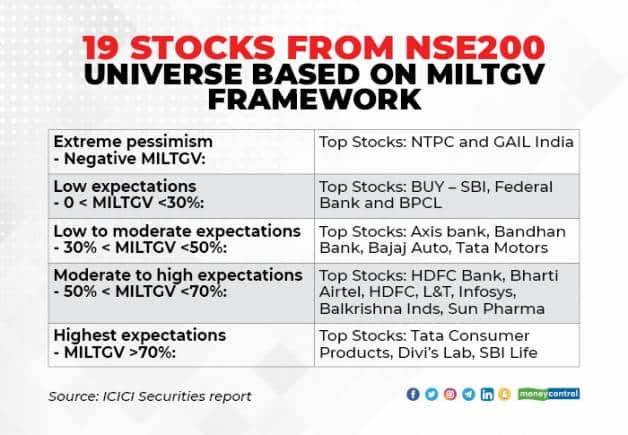
Indian markets have been under pressure in April as traders turn cautious following a surge in coronavirus cases, with daily infections seeing a record rise and topping 3 lakh for almost a week now.
The recent correction can be an entry point for some prominent and industry-leader companies in the NSE200 universe.
“Long-term growth prospects as ‘perceived’ by the collective wisdom of investors are embedded in stock prices which leads to major fluctuations in stock prices whenever those perceptions change,” ICICI Securities said in a note.
The change in perception regarding long-term prospects due to short-term events provides maximum opportunities in investing, the note said.
The domestic brokerage firm used its own proprietary MILTGV framework (Market Implied Long Term Growth Value) on the NSE200 universe stocks to classify fundamentally sound investable stocks, with upsides into segments based on the market’s degrees of pessimism or optimism.
With the focus on long-term growth, ICICI Securities prefers stocks with relatively lower environmental, social and corporate governance (ESG) risk or the riskier ones showing improvement in their score.
Why is MILTGV superior to a P/E ranking for measuring Mr Market’s optimism/pessimism?
P/E ratio as a relative valuation tool does not indicate the underlying risks to a business. ICICI Securities MILTGV framework discounts the earnings base by the cost of equity (Ke) of individual stocks (based on the CAPM model), thereby appropriately discounting risky earnings.
Currently, the concept working in favour of the above strategy is the trend of low estimation error in forecasted earnings which improves the readings.

Extreme pessimism—Negative MILTGV
The market is assigning a negative value to long-term growth in earnings beyond FY23 for 18 stocks, which implies an expectation of negative or near-zero growth beyond FY23 consensus earnings into perpetuity.
Here stocks are largely PSUs engaged in economic activities of utilities, oil & gas and financials with a higher proportion scoring low on ESG.
Stock to buy: NTPC and GAIL India. The market’s assumption of negative growth into perpetuity appears too pessimistic for some of the stocks with prospects to grow and add value (RoE>ke) while improving ESG scores.
Low expectations—0 < MILTGV <30%
Here the market is assigning less than 30 percent of the current market value to long-term growth in earnings beyond FY23.
The consensus median earnings growth of this group is expected to be 11 percent over FY20-23 and median RoE in FY22 is expected to be 15.2 risk.
Stocks to buy: SBI, Federal bank and BPCL: Opportunity to pick improving earnings growth and minimum value creating profile stocks with long term business track record and improving or low risk ESG score.
Low to moderate expectations—30% < MILTGV <50%
The market is assigning between 30 to 50 percent of the current market value to long-term growth in earnings beyond FY23.
Stocks majorly from auto, financials, healthcare, IT and a mix of other sectors constitute the low to moderate expectations with a lower incidence of high-risk ESG scores.
The median earnings growth of this group is expected to be 13 percent over FY20-23 and Median RoE in FY23 is expected to be 16.5 percent.
Stock to buy: Axis Bank, Bandhan Bank, Bajaj Auto, Tata Motors: Opportunity to buy quality stocks with growth at reasonable valuations.
Moderate to high expectations—50% < MILTGV <70%
The market is assigning between 50 to 70 percent of the current market value to earnings growth beyond FY23.
Here the stocks filtered are majorly from sectors like cement, industrials, IT, auto, pharma, financials.
The median earnings growth of this group is expected to be 18 percent over FY20-23 and Median RoE in FY23 is expected to be 17.7 percent.
Stocks to buy: HDFC Bank, Bharti Airtel, HDFC, L&T, Infosys, Balkrishna Industries, Sun Pharma. There is an opportunity to buy quality leadership stocks with consistent earnings growth or improving growth profile albeit at a reasonable premium.
Highest expectations—MILTGV >70%
Here the market expects bulk of the value (>70%) from such stocks to be derived from long-term earnings growth rather than the earnings trajectory till FY23.
Hence, the most important factor for such stocks is the potential earnings growth over the long term, along with the adequate balance sheet strength and capital allocation decisions to achieve such high growth.
Stocks are majorly from segments like consumer, auto, financials, pharma, industrials and new-age sectors such as retail, digital and green energy.
The median earnings growth of this group is expected to be 19 percent over FY20-23 and median RoE in FY23 is expected to be 20 percent.
Stock to buy: Tata consumer products, Divi’s Lab, SBI Life.
Buying should be restricted to high-quality growth stocks (earnings CAGR > 15-20 percent) involved in economic activities which have high long-term growth visibility. Also, such stocks should be consistently beating or meeting estimates as valuation re-rating is unlikely.
Disclaimer: The views and investment tips expressed by experts on Moneycontrol.com are their own and not those of the website or its management. Moneycontrol.com advises users to check with certified experts before taking any investment decisions.
